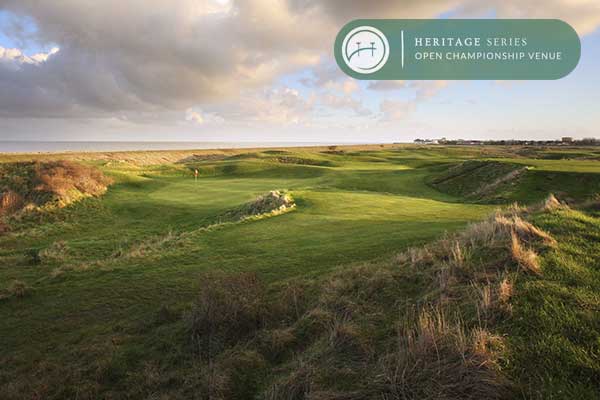Open Championship venues are amongst the most famous golf courses in the world. The Open is the oldest of golf’s Majors and is the arguably the most coveted prize in all of golf. Whilst some may wish for a green jacket, the Claret Jug is the most important piece of silverware a golfer can get his hands and name on.
Over the years, fourteen courses have hosted this great event. These courses make up the ultimate bucket-list of places to play before you die. You can recall the shots played by Open Championship greats such as Jack Nicklaus, Tiger Woods and Tom Watson as you experience these links gems for yourself.
This year, we will see the 148th playing of The Open and it marks the long-awaited return of the championship to Royal Portrush in Northern Ireland. We will take a look at the courses that make up the famed Open Rota and host this most wonderful of tournaments. These are the venues where champion golfers are crowned and chapters of golfing history are written.
Prestwick Golf Club
Scotland (1860-1925)
In 1860, Prestwick Golf Club became the very first Open Championship Venue. Yes, this is where it all began and the clubhouse has the incredible memorabilia to prove it. The first playing of The Open was played over a twelve-hole layout which was repeated three times. The Open was held at Prestwick 24 times between 1860 and 1925 making this the second most played Open Championship venue.
The course has some unique features thanks to its age, Old Tom Morris was responsible for the layout of the course and the 2nd, 4th and 5th holes are still in their original form. The 5th hole is a 500-yard dogleg par five that runs out of fairway around 300 yards from the tee. It is replaced by the feature that provides the hole a name, the ‘Cardinal’ bunker. This immense hazard is reinforced with railway sleepers and is a place on the course to avoid at all costs. If you truly love golf and its captivating history, you simply must play here at least once. This is a golfing venue of such importance, it is the birthplace of major championship golf.
The Old Course at St Andrews
Scotland (1873-present)
From 1872 – 1892, there was more than one Open Championship venue as The Royal and Ancient Golf Club and The Honourable Company of Edinburgh Golfers joined adding their courses to the rota. In 1873, The Old Course at St Andrews hosted its first of 29 Open Championships. As “The Home of Golf”, The Open is held here every five years and the 150th edition of the tournament will be played on the famous links in 2021.
St Andrews was the first 18-hole course in the world and the reason we play that number of holes to this day. There are seven double greens and four single greens on the course, this unique design can leave you facing some colossally long putts but is great for those who track greens in regulation stats. The 17th hole is one of the most iconic holes on the course. Teeing off over The Old Course Hotel, you aim for a narrow strip of fairway on a left to right dogleg par four. The approach to “The Road Hole” is a tricky one with the incredibly penal that shares a name with the hole and a wall that demarcates the hole. This is all well and good but the green is a thin and wildly undulating strip of dancefloor. A really tough hole and a place where many potential Open Champions have lost their grip on the trophy.
The Old Course at Musselburgh Links
Scotland (1874-1889)
This was once the home of the Honourable Company of Edinburgh Golfers (HCEG) and the course they put forward to be an Open Championship venue. The 9-hole course hosted six Opens between 1874 and 1889. This is a course that has left a fundamental and indelible mark on the game, it was the first club to cut holes at four-and-a-quarter inch, the standard size we still use today.
The course still exists in its 9-hole form and is unchanged from its days as an Open Championship venue. This is a very old-fashioned course, however, it remains a fun test of golf especially if the winds get up. One of the best holes on the course is the par three 8th. This was the final hole added to the course in preparation for hosting The Open in 1870 and is a challenging hole at 240 yards. The green is slightly elevated and shots going long may end up in a hidden bunker behind the green. A par here is a good score to take onto the final tee.
Muirfield
Scotland (1892-present)
This course was also built by the HCEG and remains where the club play their golf. This, for many golfers, is the greatest Open Championship venue of them all and last held the tournament in 2013 when Phil Mickelson was crown Champion Golfer of the Year. This course was originally 16-holes and was designed by Old Tom Morris. It is thought that when two more holes were added then Harry S. Colt and Tom Simpson refurbished it, Muirfield became a truly special links course.
Fifteen Open Championships have been held at Muirfield a course which broke the ‘nine-out and nine-back’ mould. This masterpiece is made up of two rings of nine holes that start and end at the clubhouse. One of the best holes across the entire Open Rota is the 191-yard par three 13th. The deep green slopes severely back to front meaning that you need to leave your ball short of the flag for any hope of a good putt. However, five of the most dastardly links bunkers await anything off-line and finding any of them will make getting par a formidable task.
Royal St George’s Golf Club
England (1894-present)
In 1894, Royal St George’s Golf Club became the first Open Championship venue out-with Scotland. This course is set in some very dramatic dunes and used to have many blind holes. Over the years, the course has been tamed somewhat but it still has the tallest and deepest bunker in the UK. Royal St George’s is still the only course on the Open Rota in southern England and it is a perfect example of wild natural links. The Open Championship will return here in 2020, the first time it has hosted the event since Darren Clarke won here in 2011.
Royal St George’s is one of those memorable rounds of golf with each hole standing out on its own as a truly great hole. The fairways here are one of the biggest challenges as they undulate their way through the course. As you go to play your second shots, often with a long-iron, you can be faced with a tricky sloping lie which will test your creativity. This is a shot-makers course, one that requires bold and well-struck golf shots. The 15th hole is incredibly easy on the eye and a really classic links hole. This long par four is arguably the hardest hole on the course at 493 yards from the championship tee. There is a wonderful symmetry about the hole as fairway bunkers await tee shots lost to the left and right. Your approach shot entices bravery as anything short will face a tough bunker shot. Take your par, or even a bogey, and be happy with yourself.
Royal Liverpool (Hoylake) Golf Club
England (1897-present)
Like many of the clubs mentioned so far, Royal Liverpool, or Hoylake as it is more commonly known, has had a significant role in the history of golf. It was here that the rules of amateur status in golf were decided and also where The Amateur Championship and Walker Cup was born. Harry Colt is largely responsible for the wonderful course that we see today and Hoylake will be an Open Championship venue for the 13th time in 2022. This is the second oldest links course in England and the terrain is very flat for most of the round which means that the coastal winds play a considerable part in the round. Tiger Woods won here in 2006 and Rory McIlroy followed him in 2014.
For most who have played here, the stretch of holes along the shore around the turn is the highlight of the round. At this point in the course the land is more dramatic which lends itself to more exciting golf. Standing at the tee on the 9th, you get a glorious panorama before you drive on this 391-yard par four. The 10th is a lovely dogleg that tempts you to cut the corner with the placement of three fairway bunkers awaiting those who go too safe. The 11th is a great links par three with dune-laden terrain and a distracting view. This is one of the highlights of the round and one of the iconic images of the golf course.
Royal Cinque Ports Golf Club
England (1909 and 1920)
Given the coastal nature of links courses, weather can play a huge role in the shape and playing experience of Open Championship venues. However, the weather was not the friend of Royal Cinque Ports and actually caused it to be removed from the Open rota. Having held the great event in 1909 and 1920 this beautiful course looked set to host many championships. Royal Cinque Ports was scheduled in 1938 and 1949 to hold The Open but nature wasn’t having it. Abnormally high tides flooded the course and meant that Royal St George’s had to host the event on these occasions, The Open never came back. The Great Wars also caused a lot of damage to the land and James Braid was brought in to restore and improve the course.
Royal Cinque Ports is widely regarded as one of the most challenging of all links courses in the UK. You inevitably spend the first eleven holes creating a buffer of shots so that you can finish the final seven holes in ‘damage-limitation mode’. This closing stretch tends to play into the wind and can be relentless. Of these closing holes, the 16th can actually be a good birdie chance to help you finish strong. The newly revamped hole is now a par five with a split fairway which tends to suit a three-shot strategy. Enjoy the brief rest here before you play out the final holes.
Royal Troon Golf Club
Scotland (1923-present)
In 1923, Royal Troon became an Open Championship venue and golfing lore suggests that this is because the HCEG members did not want the tournament at Muirfield that year. James Braid was drafted in to modify the course for the most prestigious tournament it had ever held. In 2012, one the greatest moments in modern Open history took place at Royal Troon as Henrik Stenson and Phil Mickelson played an epic head to head round in the final pairing. In the end, a 62 from the Swede was enough to make him a major champion for the first time.
Braid’s alterations created the most famous par three in Open Championship golf, the ‘Postage Stamp’ 8th hole. This devilishly tricky hole is the shortest hole on the Open Rota but one that can really make the best players in the world struggle. This hole is all about accuracy. A miss short or onto the false front of the green will roll down the hill into a tough position for an up and down. If you miss slightly right you are in a narrow coffin bunker that will kill your hopes of par. Royal Troon is a wonderful links course with top-class golf holes in droves.
Royal Lytham & St Anne’s
England (1926-present)
This is the most northerly English Open Championship venue and, although unmistakably a links, this course is not by the sea. Thanks to 167 bunkers, this course is an incredibly challenging golf course, only Carnoustie is thought of as more difficult. The splendour of the Victorian clubhouse behind the final green is one of the iconic images of the club. This is a course that is kept in immaculate condition and seems to be forever ready to host The Open at a moments notice.
To play well at Royal Lytham & St Annes takes sound strategy and execution, this is not a course you can scramble around. There are many great holes on the course and the highlight would probably be the 17th. This long par four was the sight of a phenomenal shot that won Bobby Jones The Open as an amateur in that first Open at Lytham. It is also worth noting that the first hole is the only par three starting hole on the Open rota too. The course is a unique and charming place to play and it is packed with history for you to drink in.
Carnoustie Golf Links
Scotland (1931-present)
It was clear that Prestwick was no longer the Open Championship venue it had once been, this was a big name to replace and so it took something special to do that, in stepped Carnoustie Golf Links. A course, to this day, thought to be the most difficult of all Open courses and maybe of all major venues. Carnoustie has hosted eight Open Championships, most recently in 2018, when Francesco Molinari won. More famously, who could forget Jean Van De Velde losing The Open to Paul Lawrie on the 72nd hole in 1999?
There is a great feeling of understated class on the Championship Course at Carnoustie. The course is just a joy to play and one that requires your best golf over nearly every shot. The closing holes at Carnoustie make for an incredibly tough finish. The Barry Burn weaves through the 17th and 18th holes creating a hazard from the tee and to your approach shots just as you are clinging onto whatever score you have. This is one of those courses that, when all is said and done, you can be proud of whatever score you have finished with as you probably had to work very hard for it. Don’t be put off by the challenge, accept it and enjoy it, this is the truest of links tests.
Prince’s Golf Club
England (1932)
The year after Carnoustie held its inaugural Open, another new course was given a chance at being an Open Championship Venue. Prince’s Golf Club only had the honour of hosting one championship due to the damage done by the Second World War. However, that solitary Open was to be the unveiling of a piece of technology that still occupies a place in virtually every golf bag. The winner that year was Gene Sarazen and much of his victory is credited to his secret weapon, the sand wedge. This was the first time such a club was used and the original club was held at the club until recently.
After the war, seventeen of the original greens were saved and the course now exists as three sets of nine holes. Many regard the combination of the ‘Dunes’ and ‘Shore’ loops to be the best but the ‘Himalayas’ has recently been refurbished and is an incredible nine. The 5th hole on the ‘Shore’ loop is the old 18th green and where Sarazen won The Open in 1932. This is a solid par four that requires two well-hit golf shots on to the sloping and historic green.
Royal Portrush Golf Club
Northern Ireland (1951-present)
The eyes of the golfing world will turn to Royal Portrush this year as it hosts the 148th Open. Like Prince’s, Royal Portrush is the only other club to have been an Open Championship venue once, although that is about to change. This is the only course on the rota that is outside of mainland Britain and, for many, it is long overdue a return of the great event.
The drama of the venue builds before you even arrive at the course. The coastal drive is captivating and then, suddenly, a world-class links course just appears! The course that will host The Open this year is a new configuration as two holes from the Dunluce Course have been replaced by land from the Valley course. The sixteenth hole is a signature hole and one that will cause some drama on the final day if the tournament is tight. Aptly called ‘Calamity Corner’, this 236-yard par three plays uphill with a ravine awaiting anything short and right. This tee shot will test the nerve of any champion in waiting as troubling mounds await tee shots that are overly bold. This will be a truly wonderful open championship venue.
Royal Birkdale Golf Club
England (1954-present)
The layout of Royal Birkdale has a unique backstory as three generations of the Hawtree family have shaped the course. The current set-up is mainly the work of Frederik Hawtree. Birkdale was supposed to become an Open Championship venue in 1940, however, the Second World War caused the event to be cancelled and it was fourteen more years before it had the honour. It has since gone on to host ten Opens and is regarded by many as the finest Open course in England.
The course, with its high dunes and flat fairways, is great for watching and playing, respectively, and has many great golf holes to boast of. The final hole is arguably the best on the course especially thanks to the drama it has been the setting for through the years of Open history. This long par four requires two perfectly struck shots, especially when the wind is up. Plenty of bunkers will punish waywardness whilst a wild tee shot can end up OB. This is a fitting end to one of the world’s finest links experiences.
Turnberry
Scotland (1977-present)
The most recent course to be added to The Open Rota, this is a course that has been home to some of the highest drama on and off the course in the history of the tournament. 1977 was the first time that Turnberry was an Open Championship venue and it put itself on the map with the famous ‘Duel in the Sun’. Much like Stenson vs Mickelson at Royal Troon in 2012, this was a head to head between two of the best of all time as Nicklaus and Watson battled it out in the fourth round. Watson would walk away with the Claret Jug that year. In 2009, Watson, 59 years old at the time, was runner-up as Stewart Cink defeated him in a playoff to become, unfortunately, the most unwanted Open Champion in history.
In recent years, the course was purchased by Donald Trump and due to political issues and problems during The Ladies Open Championship, the course was temporarily suspended from the rota, it is still on it though. The newly reimagined course is one of the best courses in the world and a fine example of dramatic coastal links. With the famous Turnberry lighthouse as a focal point and views of Ailsa Craig and Arran as part of the backdrop, this is a special place to play golf. The 10th hole is hard to beat as a highlight of the round. Teeing off beside the lighthouse, this par five doglegs along the shoreline, brave golfers can cut the corner, and down to a green sitting on a peninsula of sorts. A wonderful hole that sums up the quality of the property.
Summary
The Open Championship has a history that no other event in professional golf can compete with. It is the only major played on links land and is still a chance for golfers to show how modern technology and skills match-up to the original land upon which the sport should be played.
We are on the cusp of another episode of the great golfing drama and another chapter in the annals of golf will be written. With such great courses hosting the event, it is no wonder that some of the best tales of golfing heroism have been born from this championship. One thing is clear, becoming Champion Golfer of the Year is the highest honour in golf and these wonderful links venues should be cherished.















